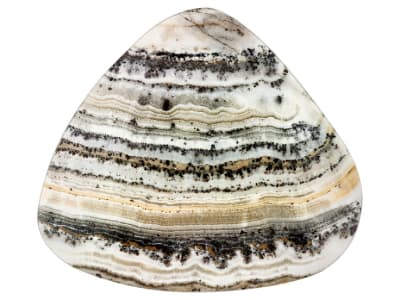Onyx is a variety of chalcedony that exhibits parallel bands of color, primarily black or white. Natural black onyx does exist, although it is rare. Most of the black onyx on the market has been treated using the sugar-acid method to produce the black color. Natural onyx has long been used for cameos and decorative objects.
General Information
LWUV: Inert
Onyx Colors
-
 Bi-color
Bi-color -
 Black
Black -
 Blue
Blue -
 Brown
Brown -
 Gray
Gray -
 Green
Green -
 Multi-color
Multi-color -
 Orange
Orange -
 Pink
Pink -
 Purple
Purple -
 Red
Red -
 White
White -
 Yellow
Yellow
Alternate Names
True Onyx, Arabic Onyx
Countries of Origin
Uruguay; United States of America; Madagascar; Thailand; India; Canada; Pakistan; Unknown; China; Ireland; Brazil; Italy; Mexico; South Africa; Peru; Germany; Indonesia
History
Most black onyx is banded with white in its natural state. It is dyed to emphasize the banding or to eliminate the banding, based on the stone's intended use. Banded stones are ideal for cameos and carvings. Each creates a unique design and is never exactly like another. Onyx is a chalcedony. It's dyed in pleasing blue shades, crisp greens, bright pinks and even white. Primarily known for its deep black color, onyx is a favorite gemstone of jewelry professionals and consumers alike. Paired with summer whites, black onyx adds sophistication to any look.
Care
Much of the onyx sold today is dyed to enhance its color and to afford you years of enjoyment. As with all color-enhanced stones, clean with warm water and mild soap. Rinse thoroughly and dry with a soft cloth. Do not use chemicals, ultrasonic or steam cleaners.
More About Onyx
Somewhere around the mid-1500s, a noted mathematician and astrologer named Girolamo Cardona, wrote that, in India, onyx was used to cool love's ardor. Hmmm… Onyx is listed in the bible as one of the stones on the breastplate of judgement.Other cultures felt that onyx could be used to separate one from an unhappy or unhealthy relationship.Often worn as "mourning jewelry", some people believed that black onyx released sorrow and negative energy.As with all folklore, there is no science that confirms the folkloric attributes of onyx. We can confirm, however, that this shining stone is striking in the right setting and a must-have for any woman's jewelry collection.
